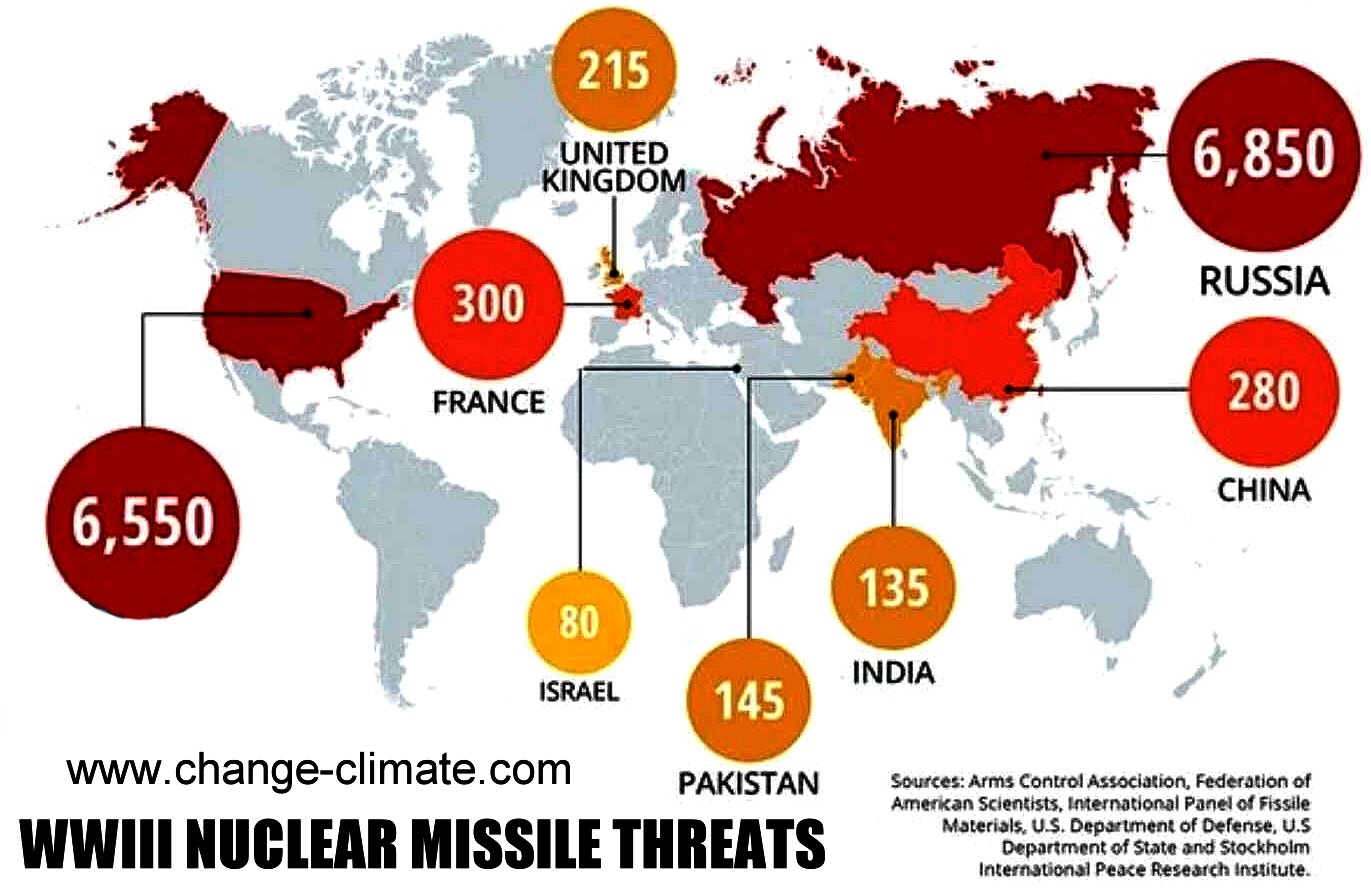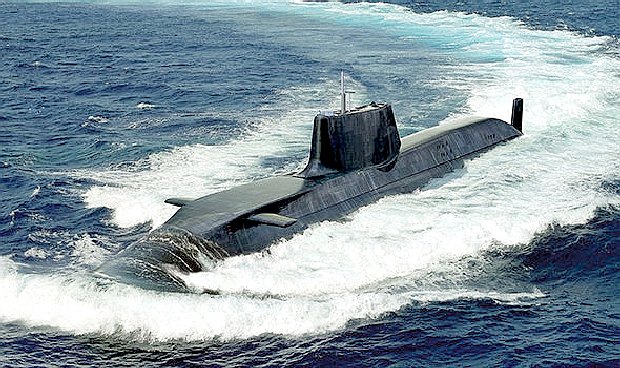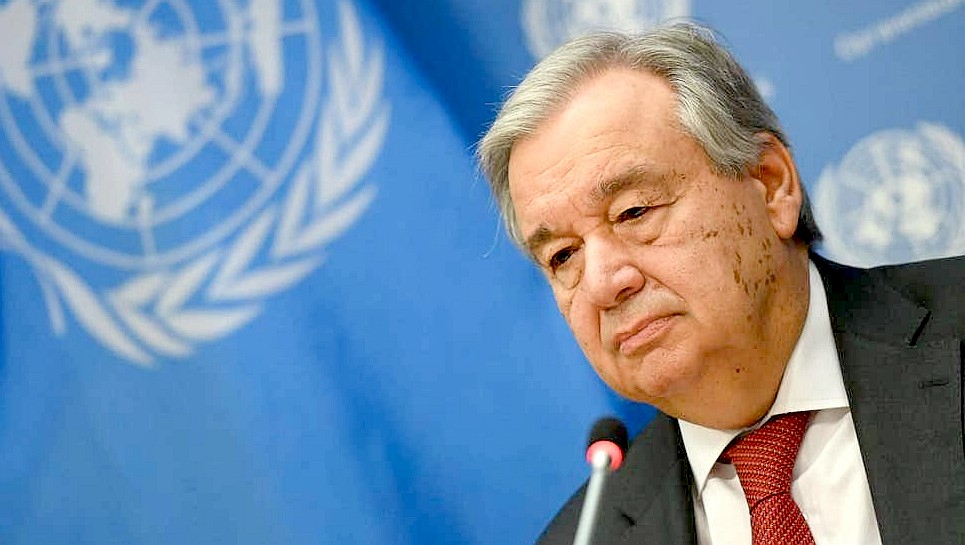|
1ST STRIKE CAPABILITY
Please use our A-Z INDEX to navigate this site, where page links may lead to other sites
TOTAL WIPE OUT CAPABILITY - According to expert analysis the world has 14,555 nuclear missiles, that would undoubtedly be fired in the event of an all out thermonuclear war. In the wake of Hiroshima and Nagasaki, that quantity of strikes would be enough to destroy all life on earth, save for the oceans. Clearly, world leaders are insane. How could any rational person build up dangerous toxic weapons to this level. The madness must be infectious and that infection is bound to lead to destruction of the planet as we know it. All it takes is one itchy trigger finger.
With a growing population and the limited resources planet earth has, now having to go further, but with global warming, marine litter and acid oceans physically and measurably reducing edible produce, World War Three seems to be inevitable. With that in mind, there will be some prepared for such eventuality, having underground bomb shelters, weapons, survival skills training and the like. And there will be others making no plans to survive a nuclear holocaust, one thousand times as devastating as Hiroshima & Nagasaki combined.
The writing is on the wall with the IPCC's Code Red, as it will affect agriculture from desertification, and toxic fish, becoming less attractive as a protein source to the expanding middle class, WW3 may start to look like at attractive proposition to world leaders, looking for a way out. The risk being that all they have built up during peacetime could be destroyed. But that this notion could be counterbalance with taking control of all of the World's resources, by one dictator, with one goal.
If that is how it is going to end, don't bother campaigning for common sense in tacking climate change or pollution, spend your time wisely learning how to cope in an irradiated world, where other humans are a potential food source. We might as well prepare ourselves for the next conflict - and hope to survive the initial blasts. It's a new kind of war with different survival skills, that we are sure many high ranking officials have rehearsed and possibly even believe they might survive.
Nuclear subs are powered by a nuclear reactor which is modified for use in a confined, underwater environment. These nuclear reactors produce heat, which in turn produces steam ,which works on the steam turbines and turns a shaft. This shaft is connected to the propeller as well as a generator which recharges the battery for on board use. This nuclear reactor gives them an unlimited range, and the ability to stay under water for months without surfacing. On-board oxygen generating systems and a large supply of food and water gives them a realistic 90 days of continuous underwater time before they need to be re-supplied.
JAPAN VISIT 2020 - U.N. Secretary-General Antonio Guterres said he will visit Hiroshima in August for the 75th anniversary of the U.S. atomic bombing of the city. The visit will be ďa way to demonstrate, not only my solidarity with Hiroshima, but my strong commitment to nuclear disarmament and nonproliferation,Ē Guterres said at a news conference at the U.N. headquarters in New York.
In 2010, then-U.N. Secretary-General Ban Ki-moon attended the Aug. 6 peace memorial ceremony in Hiroshima, becoming the first U.N. chief to do so. In 2018, Guterres became the first U.N. chief to attend the memorial event in the city of Nagasaki, where an atomic bombing took place three days after the attack on Hiroshima.
When he met with Hidehiko Yuzaki, governor of Hiroshima Prefecture, in New York last April, Guterres indicated his wish to visit Hiroshima in 2020. Hiroshima and Nagasaki were devastated by the U.S. atomic bombings in August 1945 in the closing days of World War II.
SECOND STRIKE
Throughout most of the Cold War, the United States and the Soviet Union practiced a nuclear strategy known as mutually assured destruction (MAD). That strategy involved the threat of massive retaliation against a nuclear attack, as both nations maintained arsenals of nuclear weapons large enough that either could survive a nuclear attack and still launch a devastating counterstrike. The policy maintained a nervous balance of nuclear power, with neither side willing to risk the consequences of starting a nuclear conflict. Although a first strike could theoretically launch a disabling attack against an opponent with a large nuclear arsenal, neither side was prepared to take that risk. The North Atlantic Treaty Organization
(NATO) nations formally renounced a first-strike policy, but the Soviet Union refused to go that far.
CODES RED - BLUE - The scales of war are equally applicable to the heating of the planet in terms of changing our climate. Although there has been a lot of speak about changing our ways, local authorities have carried on business as usual. That multiplied by all the Member Nations thinking the same, has taken us to the brink.
LINKS & REFERENCE
https://www.
This website is provided on a free basis as a public information service. copyright © Climate Change Trust (CCT) 2022. Solar Studios, BN271RF, United Kingdom. This website is protected by Articles 18 and 19 of the Universal Declaration of Human Rights, freedom of thought and the right to receive and impart ideas. Statute allows for media comment on policies and articles. CCT aims to comply with such international laws. Should you have any issue concerning copyright please let CCT know. You do not need our permission to reproduce our articles or pictures for educational or review purposes. Though a link back would be appreciated if not too much trouble.
|







